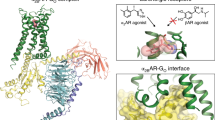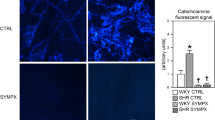Abstract
ADRENOCEPTORS can be classified into two types, α or β, according to their sensitivity to agonists and antagonists. It has been claimed that the β-adrenoceptors mediating the effect of adrenaline on the contractility of frog isolated heart are changed to α-adrenoceptors by lowering the temperature from 24 to 14 °C (ref. 1). The evidence for this suggestion was that a high concentration of the α-adrenoceptor-blocking drug phenoxybenzamine inhibits the effect of adrenaline at the low temperature but not at the higher temperature, and that the frog heart binds almost twice as much phenoxybenzamine at the low temperature than at the higher temperature. Phenoxybenzamine, particularly in high concentration, does not, however, specifically block α-adrenoceptors, and the purpose of the present experiments was to test the hypothesis of the receptor transformation by procedures not dependent on the use of this drug.
This is a preview of subscription content, access via your institution
Access options
Subscribe to this journal
Receive 51 print issues and online access
$199.00 per year
only $3.90 per issue
Buy this article
- Purchase on Springer Link
- Instant access to full article PDF
Prices may be subject to local taxes which are calculated during checkout
Similar content being viewed by others
References
Kunos, G., Yong, M. S., and Nickerson, M., Nature new Biol., 241, 119–120 (1973).
Benfey, B. G., Kunos, G., and Nickerson, M., Br. J. Pharmac., 51, 253–257 (1974).
Caron, M. G., and Lefkowitz, R. J., Nature, 249, 258–260 (1974).
Rosen, G. M., and Ehrenpreis, S., Trans. N.Y. Acad. Sci., ser. II, 34, 255–285 (1972).
Benfey, B. G., Br. J. Pharmac., 48, 132–138 (1973).
Benfey, B. G., and Grillo, S. A., Br. J. Pharmac. Chemother., 20, 528–533 (1963).
Benfey, B. G., and Greeff, K., Br. J. Pharmac. Chemother., 17, 232–235 (1961).
Peach, M. J., and Chiu, A. T., J. Pharmac. exp. Ther., 183, 73–79 (1972).
Iversen, L. L., Br. Med. Bull., 29, 130–135 (1973).
Adler-Graschinsky, E., Langer, S. Z., and Rubio, M. C., J. Pharmac. exp. Ther., 180, 286–301 (1972).
Triggle, D. J., A. Rev. Pharmac., 12, 185–196 (1972).
Berry, D. G., and Miller, J. W., Eur. J. Pharmac., 31, 176–184 (1975).
Author information
Authors and Affiliations
Rights and permissions
About this article
Cite this article
BENFEY, B. Temperature dependence of phenoxybenzamine effects and the adrenoceptor transformation hypothesis. Nature 256, 745–747 (1975). https://doi.org/10.1038/256745a0
Received:
Accepted:
Issue Date:
DOI: https://doi.org/10.1038/256745a0
This article is cited by
-
Lack of evidence for a temperature-mediated change of adrenoceptor type in the rat heart
Naunyn-Schmiedeberg's Archives of Pharmacology (1978)
-
Effect of variations in temperature on antimuscarinic activity in guinea-pig atria
Experientia (1978)
-
Temperature, phenoxybenzamine and adrenoceptor transformation
Nature (1976)
-
Temperature, phenoxybenzamine and adrenoceptor transformation (reply)
Nature (1976)
-
Alpha-receptor subsensitivity of isolated atria from rats following repeated injections of phenylephrine or isoprenaline
Experientia (1976)
Comments
By submitting a comment you agree to abide by our Terms and Community Guidelines. If you find something abusive or that does not comply with our terms or guidelines please flag it as inappropriate.



